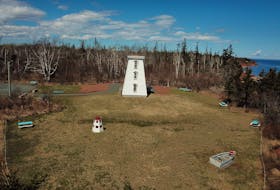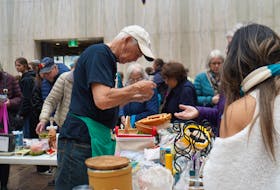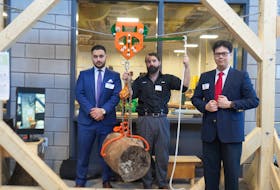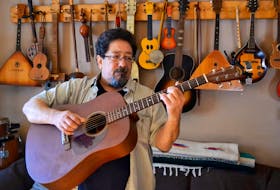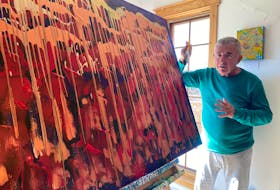Josh Silver hopes that nobody notices his students' contribution to St. Dunstan's Basilica in Charlottetown.
"Which to us, in a sense, is a compliment – that means we've done our job perfectly," he said.
Since 2018, the instructor and students of Holland College's heritage retrofit carpentry program have been conserving the historic basilica's front entrance doors, one set at a time. All three sets are made of oak wood, are three inches thick and are about 100 years old, Silver said.
"They're massive."

They've been swinging open and shut for P.E.I.'s faithful since the basilica's construction was completed in 1919, so Silver is thankful the Catholic diocese of Charlottetown had faith in his program to handle their restoration.
"The weight of the project on our students is significant in that it's a very, very prominent building – easily the top five on the whole Island," he said.
The middle set of doors was successfully conserved last year. His 2019-2020 students tackled the basilica's left set, with their goal being to interfere as little as possible with the structural integrity and design of the doors.
While COVID-19 has caused delays in having them finished and re-installed, the members of Silver's team drew an interesting comparison between their work and when the doors were first installed — they both took place during a pandemic.
"In 1918, the Spanish flu blew through," he said. "One hundred years later, basically, we're working on (them), and here comes COVID."
AT A GLANCE
Rev. Keith Kennific, the current rector at St. Dunstan's Basilica, shared some words of hope regarding the role the basilica's doors have played for some Islanders over the past 100 years.
"Those beautifully-crafted doors were opened by people in the midst of every imaginable circumstance and situation – in the happiness of weddings and baptisms and life's triumphs, in the sadness of worry and failure and death," he said. "Those doors witnessed the ravages of the Spanish flu. They might remind us that fearful pandemic had its day and subsided. So will COVID-19."

Rev. Art O'Shea, a historian with the diocese, said the basilica wouldn't have opened its main floor until September 1919. By that point, the Spanish flu was at its end, but it's possible that many funerals were held in the basilica's basement during the height of that pandemic, he said.
The doors would have been brand new at the time, having been built specifically for the basilica. While many marks and incisions on their surface indicate that minor repairs or hinge changes were made, it was about time they were taken down for extensive work, he said.
"It's just the wear and tear of especially 100 years," O'Shea said. "The Island weather is quite severe on buildings, too."

O'Shea didn't know who the doors were made by, but Silver noted that there wouldn't have been many options at the time, during another global event in that century — the First World War.
"Most able-bodied males were off fighting, so to find tradespeople who could handle that type of work was very difficult," Silver said.
It takes him and his students about 100 hours to conserve the doors. But before that, there's weeks of preparation. This is partly because Silver believes that in order to be an artisan carpenter, like the ones who first built the doors, perfection is required.
"It's only experience and passion that take you to that next level," he said. "For us as teachers we couldn't ask for a better project."

Ethan Spenceley, a student in the program, said part of the challenge was dissecting and cataloguing the many aspects of the doors' design. As well, they weren't exactly easy to transport to the Holland College's workshop, he said.
"It was really heavy getting the doors off, that’s for sure."
Ashley Langdon, another student, was disappointed that COVID-19 kept them from finishing the project, but she looks forward to someday telling her kids about the role she played in helping preserve the doors of a historic Charlottetown icon.
"They're going to be there for a while."
Silver plans for next year's class to finish the project, and he hopes that his students' work lasts another 100 years.
Daniel Brown is a local journalism initiative reporter, a position funded by the federal government. Twitter.com/dnlbrown95


